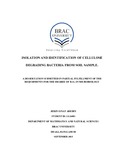| dc.contributor.advisor | Choudhury, Naiyyum | |
| dc.contributor.advisor | Hossain, Dr. Mahboob | |
| dc.contributor.author | Abedin, Jerin Isnat | |
| dc.date.accessioned | 2015-10-29T05:39:26Z | |
| dc.date.available | 2015-10-29T05:39:26Z | |
| dc.date.copyright | 2015 | |
| dc.date.issued | 2015-09 | |
| dc.identifier.other | ID 11126003 | |
| dc.identifier.uri | http://hdl.handle.net/10361/4527 | |
| dc.description | A Dissertation Submitted in Partial Fulfillment of the Requirements’ for the Degree of B.Sc. in Microbiology 2015. | en_US |
| dc.description | Catalogued from PDF version of thesis report. | |
| dc.description | Includes bibliographical references (pages 60-70). | |
| dc.description.abstract | Cellulolytic microorganisms such as fungi and bacteria are responsible for much of the cellulose degradation in soils. Despite this vast number of cellulase producers, there is a deficiency of microorganisms that can produce significant amount of the three cellulase enzyme specifities i.e. endoglucanases, exoglucanases and cellobiases to efficiently degrade cellulose to fermentable products. Little emphasis has been given to cellulase production from bacteria despite their extremely high natural diversity, which endows them with the capability to produce stable enzymes. Soil samples were collected from National parliament area & BRAC nursery. The soil samples were inoculated separately and from each, only a single bacterial isolate was obtained. The three isolates were screened for cellulolytic activity using Congo red stain on Carboxymethylcellulose (CMC) agar plates inoculated with the isolates. All the isolates were found to hydrolyze Carboxymethylcellulose. A Gram stain test carried out identified the three isolates as Gram-positive rods. Morphological and biochemical analysis indicated that they all associated mainly with members of the Bacillus sp. Isolates from BRAC nursery (CDB3, CDB4 & CDB5) selected for further functional studies bore the two enzyme specificities of a cellulase enzyme system. A crude enzyme extract was found to hydrolyze Avicel and CMC with enzyme activities of 0.326ml/mg, 0.374ml/mg, 0.352mi/mg and 0.203ml/mg, 0.206ml/mg and 0.147ml/mg respectively. Optimum temperature for activity measured over 60 minutes was found to be 30°C with relatively high activity at both 37°C and 60°C. The optimum pH at the predetermined optimum temperature was found to be pH 5.5. This | en_US |
| dc.description.statementofresponsibility | Jerin Isnat Abedin | |
| dc.format.extent | 60 pages | |
| dc.language.iso | en | en_US |
| dc.publisher | BRAC University | en_US |
| dc.rights | BRAC University theses are protected by copyright. They may be viewed from this source for any purpose, but reproduction or distribution in any format is prohibited without written permission. | |
| dc.subject | Cellulose degrading | en_US |
| dc.subject | Microbiology | en_US |
| dc.title | Isolation and identification of cellulose degrading bacteria from soil sample | en_US |
| dc.type | Dissertation | en_US |
| dc.contributor.department | Department of Mathematics and Natural Sciences, BRAC University | |
| dc.description.degree | B. Microbiology | |

